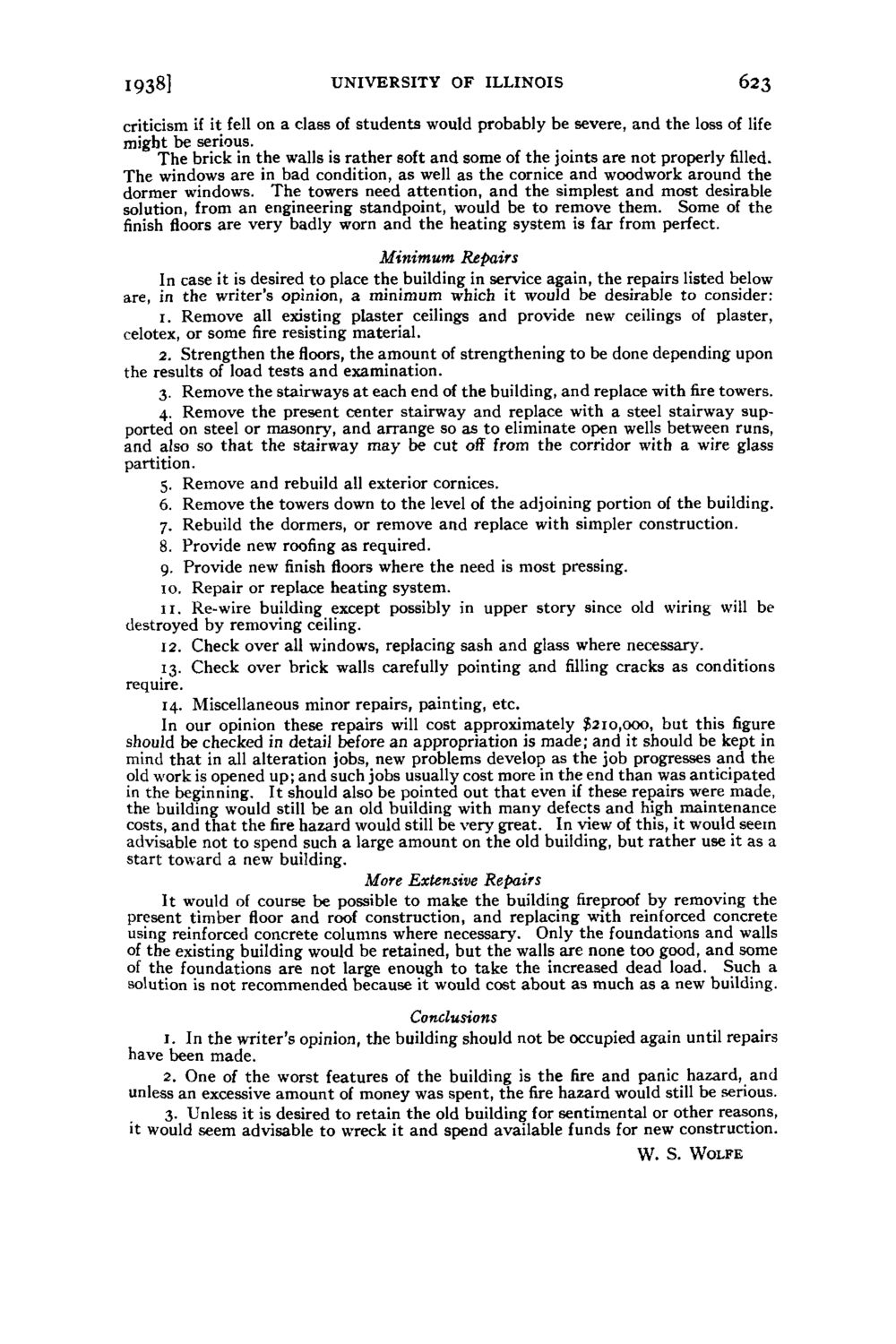| |
| |
Caption: Board of Trustees Minutes - 1938
This is a reduced-resolution page image for fast online browsing.

EXTRACTED TEXT FROM PAGE:
1938] UNIVERSITY OF ILLINOIS 623 criticism if it fell on a class of students would probably be severe, and the loss of life might be serious. The brick in the walls is rather soft and some of the joints are not properly filled. The windows are in bad condition, as well as the cornice and woodwork around the dormer windows. The towers need attention, and the simplest and most desirable solution, from an engineering standpoint, would be to remove them. Some of the finish floors are very badly worn and the heating system is far from perfect. Minimum Repairs In case it is desired to place the building in service again, the repairs listed below are, in the writer's opinion, a minimum which it would be desirable to consider: 1. Remove all existing plaster ceilings and provide new ceilings of plaster, celotex, or some fire resisting material. 2. Strengthen the floors, the amount of strengthening to be done depending upon the results of load tests and examination. 3. Remove the stairways at each end of the building, and replace with fire towers. 4. Remove the present center stairway and replace with a steel stairway supported on steel or masonry, and arrange so as to eliminate open wells between runs, and also so t h a t the stairway may be cut off from the corridor with a wire glass partition. 5. Remove and rebuild all exterior cornices. 6. Remove the towers down to the level of the adjoining portion of the building. 7. Rebuild the dormers, or remove and replace with simpler construction. 8. Provide new roofing as required. 9. Provide new finish floors where the need is most pressing. 10. Repair or replace heating system. 11. Re-wire building except possibly in upper story since old wiring will be destroyed by removing ceiling. 12. Check over all windows, replacing sash and glass where necessary. 13. Check over brick walls carefully pointing and filling cracks as conditions require. 14. Miscellaneous minor repairs, painting, etc. In our opinion these repairs will cost approximately $210,000, but this figure should be checked in detail before an appropriation is made; and it should be kept in mind that in all alteration jobs, new problems develop as the job progresses and the old work is opened u p ; and such jobs usually cost more in the end than was anticipated in the beginning. It should also be pointed out that even if these repairs were made, the building would still be an old building with many defects and high maintenance costs, and that the fire hazard would still be very great. In view of this, it would seem advisable not to spend such a large amount on the old building, but rather use it as a start toward a new building. More Extensive Repairs It would of course be possible to make the building fireproof by removing the present timber floor and roof construction, and replacing with reinforced concrete using reinforced concrete columns where necessary. Only the foundations and walls of the existing building would be retained, but the walls are none too good, and some of the foundations are not large enough to take the increased dead load. Such a solution is not recommended because it would cost about as much as a new building. Conclusions 1. In the writer's opinion, the building should not be occupied again until repairs have been made. 2. One of the worst features of the building is the fire and panic hazard, and unless an excessive amount of money was spent, the fire hazard would still be serious. 3. Unless it is desired to retain the old building for sentimental or other reasons, it would seem advisable to wreck it and spend available funds for new construction. W. S. W O L F E
| |